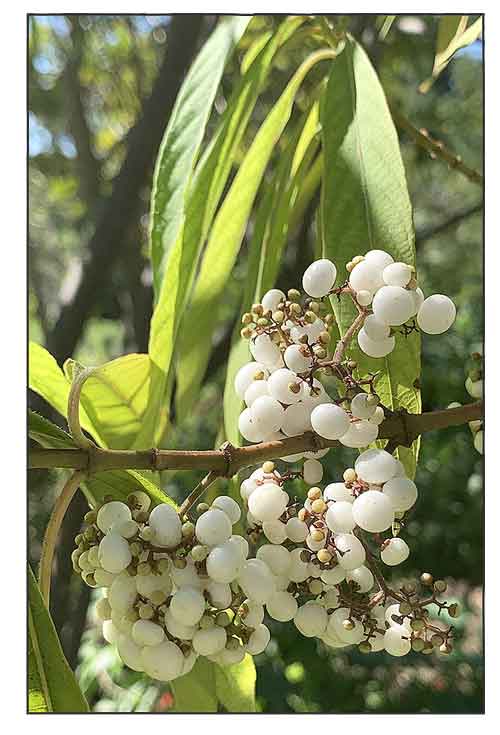 Gen info Gen info
- Callicarpa (beauty berry) is a genus of shrubs and small trees in the family Lamiacea.
Botany
• Shrubs or small trees, 1–3(–7) m tall; branchlets 4-angled, densely red-brown glandular dotted, nodes with a ring of multicellular hairs, glabrate in age. Leaves chartaceous, lanceolate, elliptic or oblong-lanceolate, usually 17–23 cm long, 3–6 cm wide, apex acute to long acuminate, base cuneate, margin obscurely serrulate to subentire, base sparsely cup-shaped glandular, subdensely to densely red-brown glandular dotted on both surfaces, subglabrous except densely multicellular hairy along prominent veins adaxially, glabrous abaxially, lateral veins 12–20 pairs; petioles 1–2 cm long, densely multicellular hairy adaxially, glabrous abaxially. Inflorescence 6–8-branched; peduncle 1–2.5 cm long; bracts linear to lanceolate. Flowers pedicellate; calyx teeth shallowly triangular, tube scabrid outside; corolla lobes glabrous on both surfaces, purplish, tube glabrous; filaments glabrous; ovary with brownish glandular dots. Fruit globose, concave at apex, ca 2.5 mm across, brownish glandular dotted. (10)
Distribution
- Native to the
Philippines. (1)
- In Luzon: Albay, Bulacan, Cagayan, Nueva Viscaya, Rizal. In lowland or medium elevation thickets and secondary forests. (3)
- Also native to China South-Central, China Southeast, Hainan, Japan, Nansei-shoto, Taiwan, Vietnam. (1)
Constituents
- Study of leaves and twigs of Callicarpa longissima isolated four new compounds (1-4), callilongisins A-D, along with five known compounds, ursolic acid, 3-oxoanticopalic acid, (E)-6β-hydroxylabda-8(17),13-dien-15-oic acid, 5-hydroxy-3,6,7,4'-tetramethoxyflavone, and artemetin. (see study below) (5)
- Study of EtOH extract of leaves and stems of C. longissima isolated two new phenylethanoid glycosides, longissimosides A and B (1,2) together with eight structurally related known compoounds.
Compounds 1 and 2 were elucidated as 1 and 2 were elucidated as 2-(3,4-dihydroxyphenyl)ethyl O-(α-L-rhamnopyranosyl)-(1→3)-O-(2-O-syringoyl-β-D-xylopyranosyl)-(1→6)- 4-O-[(E)-caffeoyl]-β-D-glucopyranoside (1) and 2-(3-hydroxy-4-methoxyphenyl)ethyl O-(α-L-rhamnopyranosyl)-(1→3)-O-(β-D-apiofuranosyl)-(1→6)-4-O-[(E)-isoferuloyl]-β-D-glucopyranoside (2). (9)
Properties
- Studies have suggest melanogenesis inhibitory, anti-inflammatory, antioxidant, anti-rheumatoid arthritis, skin-whitening properties.
Parts used
Leaves.
Uses
Edibility
- No reports found on edibility.
Folkloric
- No reported folkloric medicinal use in the Philippines.
- In traditional Chinese medicine, used to dispel bad winds and cold, enhance blood circulation.
- Leaves used for treatment of colic, diarrhea, fever, sprue, syphilis, and tumors. Leaf juice, combined with rice wine and ginger, used to treat puerperal rheumatism. Leaf juice, combined with honey, used for treatment of gastrorrhagia. Syrup from decoction of fresh leaves and sugar used for treating cough. Leaves applied externally to treat wounds and bruises. (2)
- In southern China, used as Yao folk medicine for treatment of arthritis, common cold, cough, bleeding, and abdominal pain. (8)
Studies
• Inhibition of Melanogenesis / Carnosol: Melanin, the major pigment in human skin, protects the skin against damage from ultraviolet light. An ethanolic extract of leaves of C. longissima inhibits melanin production in B16F10 mouse melanoma cells by suppressing micropthalmic-associated transcription factor (MITF) gene expression. Carnosol was determined to be the responsible for major inhibitory effect of the extract on melanin production. Carnosol and carnosic acid content in the extract was about 16% (w/w). Results suggest C. longissima is a novel and potential source of skin-whitening agents. (4)
• Bioactive Diterpenoids / Leaves and Twigs: Study of leaves and twigs isolated four new compounds, callilongisins A-D (1-4) and five known compounds. The compounds were evaluated against a human prostate cancer cell line (PC3) and for anti-inflammatory activities. (see constituents above) (5)
• Anti-Inflammatory / Antioxidant: Study evaluated the antioxidant and anti-infammatory activities of C. longissima extracts. By DPPH method, the dichloromethane, ethyl acetate, and n-butanol extracts showed strongest antioxidant capacity with IC50s of 12.39, 10.51, and 11.36 µg/mL. Anti-inflammatory activity by NO assay, showed the DCM and EA extracts to possess significant NO inhibition with IC50s of 8.75 and 7.25 µg/mL. (6)
• Anti-Inflammatory / Inhibition of TLR4/NF-kB Signaling Pathway: Study evaluated the in vitro anti-inflammatory activity of dichloromethane extract of C. longissima in a carrageenan-induced mice paw edemal model and the chemical components responsible for its activity. The DCME effectively alleviated mice paw edema induced by carrageenan. In LPS-stimulated RAW264.7 cells, DCME significantly decreased the production of IL-6 and TNF-α inhibiting their mRNA transcription, down-regulated the expression of TLR4 and myeloid differentiation factor 88, inhibited phosphorylation of alpha inhibitor of NF-kB, NF-kB p65, and degradation of IkBα. The invitro and invivo inhibition of inflammatory response is mainly attributed to the synergistic effects of abundant diterpenoid phenols via inhibition of TLR4/NFkB signaling pathway, and may promise for treatment of inflammatory diseases. (7)
• Rosmanol and Carnosol in Alleviation of Rheumatoid Arthritis: Study isolated two natural phenolic diterpenoids with anti-rheumatoid effects, rosmanol and carnosol. In type II collagen-induced arthritis in DBA/1 mice, both rosmanol (40 mg/kg/d) and carnosol (40 mg/kg/d) alleviated RA symptoms such as swelling, redness, and synovitis, decreased arthritis index score, and downregulated serum pro-inflammatory cytokine levels of IL-6. MCP-1, and TNF-α. Results demonstrated rosmanol and carnosol synergistically alleviated RA by inhibiting inflammation through regulation of TLR4/NFkB/MAPK pathway, with potential as novel, safe natural combinations for treatment of RA. (8)
Availability
- Wild-crafted.
- Dried leaves in the cybermarket.
|

![]()



 Gen info
Gen info